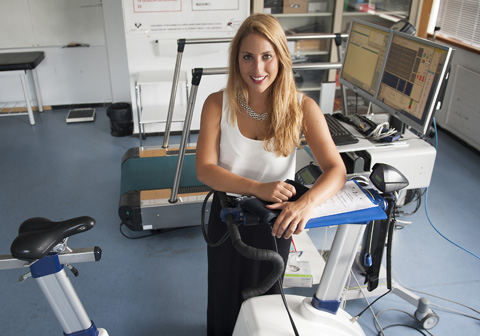For the last seven years, researchers in the UPV/EHU's Department of Physical and Sports Education have been studying the hypertensive population with excess weight/obesity and sedentary habits. In a recent publication, this group has determined the state of health of this population through various key physical, physiological, clinical and nutritional markers and has separated them by sex and physical condition.
Lifestyle changes, healthier population
A study by the UPV/EHU-University of the Basque Country has characterised the overweight or obese hypertensive population
First publication date: 20/10/2017

Obesity and high blood pressure frequently coexist in the same individual and are recognised as the main cardiovascular risk factor. The prevalence of hypertension, defined as systolic arterial pressure of ≥140 mmHg and/or diastolic arterial pressure of ≥90 mmHg and/or the prescribing of antihypertensive pharmacological therapy, is to be found in 30-45% of the general population. What is more, it is estimated right now that 69% of the population are overweight or obese and that 35% are obese individuals. That is why when controlling and preventing hypertension as well as cardiovascular disease, it is necessary to quantify cardiovascular risk since, even though a very small fraction of the hypertensive population has only high blood pressure, the vast majority display additional risk factors such as obesity, diabetes, physical inactivity, etc.
Gender difference is known to exert a different effect on the development of hypertension and cardiovascular risk. However, whether this difference could be taken as an additional factor in the prognosis and management of the disease has yet to be clarified. Yet experimental studies have determined that physical fitness or cardiorespiratory fitness is a vital sign strongly associated with cardiovascular risk (low cardiorespiratory fitness is correlated with an increase in this risk), as is an unhealthy dietary pattern.
That is why researchers in the UPV/EHU's Department of Physical and Sports Education, in collaboration with IMQ-Amárica (Vitoria-Gasteiz) and the Clinical Testing Unit (Tecnalia, Vitoria-Gasteiz), have specified the clinical, physical, physiological state as well as the dietary pattern of the overweight/obese population, in addition to physical inactivity and a hypertension diagnosis, and have also characterised them in terms of sex and cardiorespiratory fitness prior to embarking on therapeutic, non-pharmacological treatment.
Characterising the population
209 people, 141 men and 68 women, aged between 24 and 70 participated in the study conducted in Vitoria-Gasteiz and led by Sara Maldonado-Martin. All the participants were assessed through measurements at rest and under stress (anthropometric, body composition, physiological, biochemical and dietary measurements).
According to Ilargi Gorostegi-Anduaga, lead author of the paper published and a pre-doctoral student, "thanks to this work carried out over the last seven years, it has been possible to observe that the population studied, classified as metabolically, unhealthy obese individuals, display a profile of high cardiovascular risk". This profile includes a hypertension diagnosis, excess weight/obesity, high glucemic level, unhealthy values in the lipid and hepatic enzyme profile, systemic inflammation, poor cardiovascular fitness, hypertension values during physical effort and adherence to an atherogenic dietary pattern, in other words, an unhealthy dietary pattern with an unsuitable diet or eating habits that lead to the formation of fat in the arteries. What is more, even though the women displayed better biochemical and dietary pattern profiles compared with the men, their physical and physiological characteristics were poorer.
Finally, it was confirmed that greater cardiorespiratory fitness contributes towards the lessening of some cardiovascular risks, such as a high body mass index, high hepatic fat and a non-dipping nocturnal blood pressure pattern. So according to Ilargi Gorostegi-Anduaga, "the identifying of the clinical, physical, physiological and dietary patterns of this population clearly indicates the need to propose lifestyle changes, such as nutritional quality and regular physical exercise, which have beneficial effects on the cardiovascular risk factors with a view to obtaining a healthy population".
Additional information
The researchers belong to the Sports Performance Analysis Laboratory at the UPV/EHU's Department of Physical and Sports Education of the Faculty of Education and Sport.
Bibliographic reference
- Clinical, physical, physiological, and dietary patterns of obese and sedentary adults with primary hypertension characterized by sex and cardiorespiratory fitness: EXERDIET-HTA study
- Clinical and Experimental Hypertension. 2017 Aug 7:1-9
- DOI: 10.1080/10641963.2017.1346111


